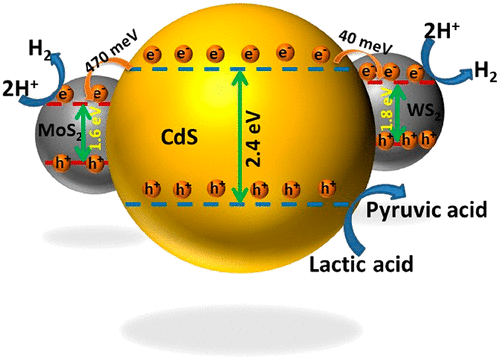当前位置:
X-MOL 学术
›
J. Phys. Chem. C
›
论文详情
Our official English website, www.x-mol.net, welcomes your
feedback! (Note: you will need to create a separate account there.)
Superior Photocatalytic Hydrogen Evolution Performances of WS2 over MoS2 Integrated with CdS Nanorods
The Journal of Physical Chemistry C ( IF 3.3 ) Pub Date : 2020-06-08 , DOI: 10.1021/acs.jpcc.0c03411 B. Archana 1, 2 , Nagaraju Kottam 1 , Sanjay Nayak 3 , K. B. Chandrasekhar 2 , M. B. Sreedhara 3, 4
The Journal of Physical Chemistry C ( IF 3.3 ) Pub Date : 2020-06-08 , DOI: 10.1021/acs.jpcc.0c03411 B. Archana 1, 2 , Nagaraju Kottam 1 , Sanjay Nayak 3 , K. B. Chandrasekhar 2 , M. B. Sreedhara 3, 4
Affiliation

|
Fabrication of noble metal-free semiconductor heterojunction composed of transition metal dichalcogenides (TMDs) and CdS is observed to be an efficient and economical photostable system for hydrogen evolution. In this report, ultrathin nanosheets of MoS2, Mo1–xWxS2 (x = 0.5 and 0.8), and WS2 integrated with CdS nanorods; hierarchical nanocomposites have been developed to improve the efficiency and durability of CdS nanorods for H2 generation. These nanocomposites exhibit outstanding H2 evolution activity with notable efficiency and excellent stability. The activity of pure MoS2, Mo1–xWxS2, and WS2 nanosheets are negligible, suggesting their cocatalytic action. The H2 evolution activities of MoS2–CdS, MoWS2–CdS, and WS2–CdS nanocomposites have been systematically studied and compared. The highest H2 evolution rates of 19.2 mmol g–1 h–1 was recorded for WS2–CdS nanocomposite (9.7 mmol g–1 h–1 for MoS2–CdS), which is 35 times higher than that of pure CdS (0.53 mmol g–1 h–1). The activity of these nanocomposites were notably superior in acidic medium (lactic acid sacrificial donor) than alkaline medium (Na2S–Na2SO3 sacrificial donor). The apparent quantum yield of 10.19% was observed in lactic acid sacrificial electron donor medium. The rational design presented here not only substantially surges H2 evolution rates but also reduces the photocorrosion of CdS. The possible mechanism has been investigated by analyzing the electronic band alignment of materials with respect to the vacuum level. Furthermore, the H2 evolution reactions were carried out under direct sunlight and in seawater to assess the performance of these nanocomposites in the practical applications.
中文翻译:

WS 2优于结合CdS纳米棒的MoS 2的光催化氢释放性能
观察到由过渡金属二卤化物(TMDs)和CdS组成的无贵金属半导体异质结的制造是一种高效且经济的光稳定氢释放系统。在本报告中,MoS 2,Mo 1– x W x S 2(x = 0.5和0.8)和WS 2与CdS纳米棒集成的超薄纳米片;已经开发出分级的纳米复合材料以提高用于H 2生成的CdS纳米棒的效率和耐用性。这些纳米复合材料具有出色的H 2析出活性,显着的效率和出色的稳定性。纯的MoS的活性2,莫1– x W x S 2和WS 2纳米片可以忽略不计,表明它们具有协同催化作用。系统地研究和比较了MoS 2 -CdS,MoWS 2 -CdS和WS 2 -CdS纳米复合材料的H 2演化活性。WS 2 –CdS纳米复合材料的最高H 2析出速率为19.2 mmol g –1 h –1(MoS 2 –CdS为9.7 mmol g –1 h –1),是纯CdS的35倍( 0.53 mmol g –1小时–1)。这些纳米复合材料的活性在酸性介质(乳酸牺牲供体)中明显优于碱性介质(Na 2 S–Na 2 SO 3牺牲供体)。在乳酸牺牲电子供体介质中观察到表观量子产率为10.19%。此处提出的合理设计不仅大幅提高了H 2的释放速率,而且降低了CdS的光腐蚀。通过分析材料相对于真空水平的电子能带对准,研究了可能的机理。此外,在阳光直射和海水中进行了H 2放出反应,以评估这些纳米复合材料在实际应用中的性能。
更新日期:2020-07-09
中文翻译:

WS 2优于结合CdS纳米棒的MoS 2的光催化氢释放性能
观察到由过渡金属二卤化物(TMDs)和CdS组成的无贵金属半导体异质结的制造是一种高效且经济的光稳定氢释放系统。在本报告中,MoS 2,Mo 1– x W x S 2(x = 0.5和0.8)和WS 2与CdS纳米棒集成的超薄纳米片;已经开发出分级的纳米复合材料以提高用于H 2生成的CdS纳米棒的效率和耐用性。这些纳米复合材料具有出色的H 2析出活性,显着的效率和出色的稳定性。纯的MoS的活性2,莫1– x W x S 2和WS 2纳米片可以忽略不计,表明它们具有协同催化作用。系统地研究和比较了MoS 2 -CdS,MoWS 2 -CdS和WS 2 -CdS纳米复合材料的H 2演化活性。WS 2 –CdS纳米复合材料的最高H 2析出速率为19.2 mmol g –1 h –1(MoS 2 –CdS为9.7 mmol g –1 h –1),是纯CdS的35倍( 0.53 mmol g –1小时–1)。这些纳米复合材料的活性在酸性介质(乳酸牺牲供体)中明显优于碱性介质(Na 2 S–Na 2 SO 3牺牲供体)。在乳酸牺牲电子供体介质中观察到表观量子产率为10.19%。此处提出的合理设计不仅大幅提高了H 2的释放速率,而且降低了CdS的光腐蚀。通过分析材料相对于真空水平的电子能带对准,研究了可能的机理。此外,在阳光直射和海水中进行了H 2放出反应,以评估这些纳米复合材料在实际应用中的性能。











































 京公网安备 11010802027423号
京公网安备 11010802027423号